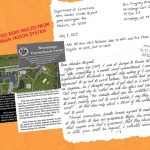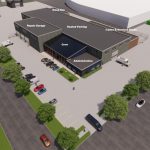Guitars float at UWM
Water trickled through the ChromaDuo’s superb classical guitar concert Friday evening at the UWM Peck School of the Arts Recital Hall. Water presented itself explicitly in the titles of two pieces and allusively in Debussy’s impressionistic works. Water also proved an apt metaphor for the duo’s effortless, perpetually moving and morphing sound.
Tracy Anne Smith and Rob MacDonald are committed to expanding guitar repertoire by commissioning and performing new music.
The commissioned Still the Sea from Welsh composer Stephen Goss in 2009. In his three movements, Goss pays homage to Japanese composer Toru Takemitsu by taking his cues from Takemitsu’s main influences: Debussy, Nature and Duke Ellington. The first movement, The Black River, uses rhythm and harmony to create the image of cascading, ever-flowing water. Steady arpeggios in the lower voice are like pebbles at the bottom of a river which the upper voice navigates melodically. Smith and MacDonald played Goss’ intricate rhythms with exacting precision, unifying their voices into a single stream. Silent Pool, the second movement and the one most directly connected to Takemitsu’s own style, boldly uses silence and softness to create expansive space and time. Like stones dropped in a glassy pool, dissonances punctuate suspended stillness. Sometimes, rests are the hardest notes to play, but Smith and MacDonald’s disciplined restraint effectively conveyed the composer’s quiet intention. Firewater burns with jazz-infused vigor and ends suddenly. Smith and MacDonald’s synchrony on this final chord was thrilling. They also played Goss’ The Raw and the Cooked.
They played two works by Parisian Roland Dyens: Commes des Grands and Niterói. Dyen wrote the latter for ChromaDuo in 2010. Dyens named after the Brazilian municipality whose name means “hidden waters” in the indigenous Tupi language. The composer pays homage to Brazilian architect Oscar Niemeyer. Not surprisingly, Niemeyer was attracted to the curves of rivers and the ocean.
Evoking indigenous Brazilian rhythms, the piece begins with the players tapping the bodies of their guitars. Later, tambour (string slapping), bends, and string tuning texture the music. A fast, frenetic section gives way to a more delicate, lyrical one. The tapping returns and the music rushes to the end.
Display picture on the Arts & Culture page courtesy of the Divrei Derech blog of Rabbi Rick Winer.




















